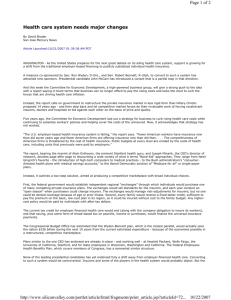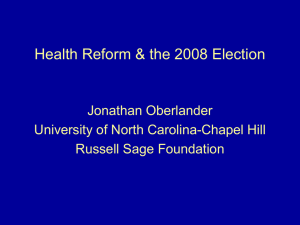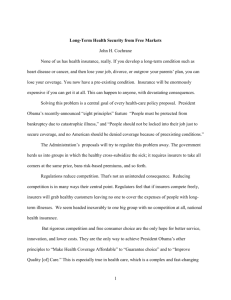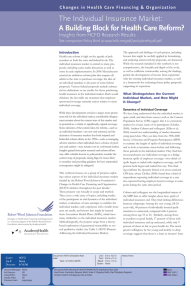policy brief The Individual Insurance Market: Why Is the Individual Insurance
advertisement
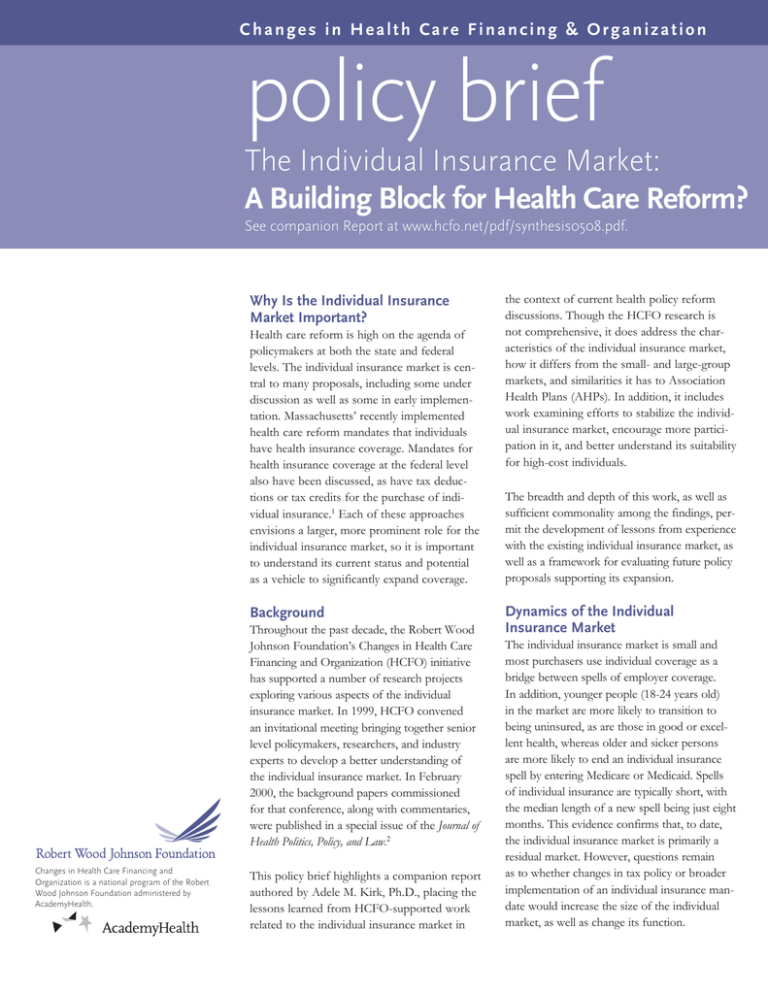
C h a n g e s i n H e a l t h Ca r e F i n a n c i n g & O r g a n i z a t i o n policy brief The Individual Insurance Market: A Building Block for Health Care Reform? See companion Report at www.hcfo.net/pdf/synthesis0508.pdf. Why Is the Individual Insurance Market Important? Health care reform is high on the agenda of policymakers at both the state and federal levels. The individual insurance market is central to many proposals, including some under discussion as well as some in early implementation. Massachusetts’ recently implemented health care reform mandates that individuals have health insurance coverage. Mandates for health insurance coverage at the federal level also have been discussed, as have tax deductions or tax credits for the purchase of individual insurance.1 Each of these approaches envisions a larger, more prominent role for the individual insurance market, so it is important to understand its current status and potential as a vehicle to significantly expand coverage. Background Throughout the past decade, the Robert Wood Johnson Foundation’s Changes in Health Care Financing and Organization (HCFO) initiative has supported a number of research projects exploring various aspects of the individual insurance market. In 1999, HCFO convened an invitational meeting bringing together senior level policymakers, researchers, and industry experts to develop a better understanding of the individual insurance market. In February 2000, the background papers commissioned for that conference, along with commentaries, were published in a special issue of the Journal of Health Politics, Policy, and Law.2 Changes in Health Care Financing and Organization is a national program of the Robert Wood Johnson Foundation administered by AcademyHealth. This policy brief highlights a companion report authored by Adele M. Kirk, Ph.D., placing the lessons learned from HCFO-supported work related to the individual insurance market in the context of current health policy reform discussions. Though the HCFO research is not comprehensive, it does address the characteristics of the individual insurance market, how it differs from the small- and large-group markets, and similarities it has to Association Health Plans (AHPs). In addition, it includes work examining efforts to stabilize the individual insurance market, encourage more participation in it, and better understand its suitability for high-cost individuals. The breadth and depth of this work, as well as sufficient commonality among the findings, permit the development of lessons from experience with the existing individual insurance market, as well as a framework for evaluating future policy proposals supporting its expansion. Dynamics of the Individual Insurance Market The individual insurance market is small and most purchasers use individual coverage as a bridge between spells of employer coverage. In addition, younger people (18-24 years old) in the market are more likely to transition to being uninsured, as are those in good or excellent health, whereas older and sicker persons are more likely to end an individual insurance spell by entering Medicare or Medicaid. Spells of individual insurance are typically short, with the median length of a new spell being just eight months. This evidence confirms that, to date, the individual insurance market is primarily a residual market. However, questions remain as to whether changes in tax policy or broader implementation of an individual insurance mandate would increase the size of the individual market, as well as change its function. policy brief — Changes in Health Care Financing & Organization (HCFO) Lessons Learned The Current Individual Insurance Market • The current individual market is a residual market, where individual coverage generally serves as a bridge between other insured states. • How many more consumers would be enticed into the market and how long they would stay would depend on the range of products and prices they face. • The large-group, small-group, and nongroup markets are fundamentally different markets, with different products, different sales channels, different companies, and very different regulatory environments. • Increased price-sensitivity and mobility in the individual market can lead to market instability. • No matter how large it grows, the individual market is unlikely to acquire the characteristics of the large-group market. • An individual mandate may result in an influx of lower-risk individuals into What Makes the Individual Market Different? The individual market is distinct from the large- and small-group health insurance markets. These markets offer different products through different sales channels and different companies. They also operate in different regulatory environments. In the individual insurance market, the individual seeking coverage chooses whether to purchase coverage, as well as what product to purchase, when, and for how long. The individual is fully aware of the price and is at liberty to base his or her decision on personal tastes, health conditions, and anticipated need. In the group market, employers not only subsidize insurance premiums, but also make decisions about the timing of coverage, as well as the insurance product, resulting in health insurance being intrinsically related to one’s job. Better awareness of cost, as well as increased mobility and knowledge of health insurance options, can lead to more instability in the individual insurance the individual insurance market, but if enrollees are offered lower-cost coverage in the group market, they are likely to take it, potentially affecting the stability of the market. • Lower prices in the individual market, when present, are more likely the result of risk segmentation than low administrative costs. • Preemptive, defensive pricing in the individual market can turn insurers’ fears of adverse selection into self-fulfilling prophecies, since high rates deter all but the sickest from enrolling. Lessons from Reform Efforts • Consumers and insurers respond to the incentives established through reform, both those that are intended and those that are not. • It is important to formulate state and federal health insurance market policy in ways that do not exacerbate the sometimes shaky relationships at the intersection of the individual, small-group, and large-group markets. market than in group markets. The transitory nature of the individual market, with people entering and exiting frequently, increases the potential for adverse selection. In response, insurers in the individual insurance market typically underwrite aggressively, and the underwriting and oneon-one nature of policy sales lead to high administrative costs. In addition, in most markets there is one dominant insurer with little competition. Lessons from Association Health Plans Some policymakers propose greater use of AHPs as a vehicle to offer the benefits of group coverage to individual purchasers. AHPs are group health plans sponsored by trade, industry, professional, chamber of commerce, or similar business associations. They share many characteristics with the individual market, including the increased price awareness and mobility of individual purchasers. While AHPs are group plans and, theoretically, offer increased negotiating strength and lower rates than page 2 • Federal policy must consider market boundary issues and define what sorts of policies would qualify for the favorable tax treatment—not only in terms of scope of benefits, but also with regard to the regulatory status of the policy in the purchaser’s state of residence. • In a larger market with more permanent policyholders, consumers might be willing to pay some additional cost for the smoothing effect on premiums that guaranteed renewal provides. However, this is contingent on insurers honoring their commitment to provide long-term coverage. • When implementing tax credits, especially for an economically stressed population, insufficient subsidy and a delay in implementation or uncertainty about the program can result in low participation. • High-cost individuals affect the behavior and stability of the individual insurance market, which must be anticipated when considering policies that would expand the market. in the individual market, individuals usually pay the entire premium and make their own purchasing decisions, much as they would in the individual market. As a result, administrative costs remain high and potential instability caused by adverse selection remains a risk. Typically, AHPs operate across state lines and, even when operating within states, they often are exempt from group insurance regulation. Experience with AHPs, and attempts to regulate them at the federal level, point to the importance of formulating health insurance market policy in ways that do not exacerbate the sometimes shaky relationships at the intersections of the individual, small-group, and largegroup markets. For example, if tax policy is changed, policymakers will need to give careful thought to defining which policies qualify for favorable tax treatment—not only in terms of scope of benefits, but also with regard to the regulatory status of the policy in the purchaser’s state of residence. policy brief — Changes in Health Care Financing & Organization (HCFO) Efforts to Reform and Stabilize Individual Insurance Markets The Role of Guaranteed Renewal Guaranteed renewability assures a policyholder that his or her health insurance coverage will not be cancelled at the end of the contract period. The Health Insurance Portability and Accountability Act of 1996 (HIPAA) requires most health insurance policies to be guaranteed renewable. Many, although not all, states also prohibit carriers from re-underwriting coverage at renewal. Therefore, rate increases reflect the cost experience of the policyholder’s rate class, not the policyholder’s own claims experience. There is debate about the extent to which guaranteed renewability alone can stabilize the individual market. Theoretically, insurers could incorporate a charge for guaranteed renewal into the premium, assuming that over time an individual will experience increasing losses. However, doing so might dissuade young, healthy purchasers from purchasing the policy and consumers might not trust insurers to honor their commitment to long-term coverage, fearing that they will stop offering certain policies or exit the market entirely. Research shows that current enrollees appear to pay premiums that approximate an optimal premium for a long-duration policy with guaranteed renewal. However, as previously discussed, other work suggests the current individual insurance market is characterized by short stays—including some unknown portion covered by short-term or bridge policies that do not include guaranteed renewability. These policyholders stay in the market for only a short time, and pay a premium with a charge for guaranteed renewability without ever reaping its benefits. In a larger market with more permanent policyholders, this work suggests that consumers might be willing to pay some additional cost for the smoothing effect on premiums that guaranteed renewability provides. Guaranteed renewability does not protect policyholders when companies exit the market or stop offering a particular policy. In addition, policyholders are unable to move from one policy to another if their needs change. As a result, agents are reluctant to sell products from companies with a small market share, since they are more likely to exit the market or reduce their offerings. The value of guaranteed renewability to consumers is contingent on insurers honoring their commitment and eschewing practices such as durational rating and closing policies to manage risk. Premium Subsidies via Tax Credits: The Case of the HCTC Many current proposals incorporate tax deductions or tax credits to encourage individuals to purchase coverage in the individual market. The experience of a limited tax credit program provides some insights into the challenges of using that approach. Congress enacted the Health Coverage Tax Credit (HCTC) as a component of the 2002 Trade Adjustment Assistance Reform Act. The HCTC provides a 65 percent premium subsidy to trade-dislocated workers, certain early retirees, and dependents of both groups. Subsidies were provided as advance-payment tax credits. Interestingly, only a small fraction of those eligible for the tax credit took advantage of it. Researchers hypothesized that even the 35 percent of the premium required from participants may have been unaffordable. In addition, the program placed no limit on premiums charged and many states provided coverage through their high-risk pools or other insurer-of-last-resort mechanisms, which could have very high premiums, especially for older or higher-risk individuals. There also were delays in initial subsidy payments, which discouraged enrollment, and administrative costs were high for all program participants, including the Internal Revenue Service and private insurers. Although the HCTC was a limited program targeted to a narrow group, it represents a first effort to implement federal tax credits for health insurance, and thus holds important lessons for those contemplating federal premium subsidies on a larger scale. Insufficient subsidies for an economically page 3 stressed population were one major reason for low participation—a problem exacerbated by high premiums. As with HIPAA, the HCTC created a right-to-coverage for a class of individuals, but remained silent on the issue of cost, leaving it to the states to decide how affordable coverage should be. Evidence suggests that many participants were charged premiums much higher than warranted by their subsequent claims experience. Such preemptive, defensive pricing can turn insurers’ fear of adverse selection into a self-fulfilling prophecy, since high rates deter all but the sickest from enrolling. In this case, subsidies appeared to buffer that effect (the federal government picked up 65 percent of the premium cost), suggesting that subsidies can dampen the volatility of individual markets. But this result came at a high cost to the taxpayer and the policyholder, who in addition to covering high administrative cost also may have paid actuarially unfair premiums. In addition, most of the administrative costs may have been attributable to the one-onone, retail nature of the transactions, thereby being unlikely to disappear or diminish with a larger program. Comprehensive State Reform In the mid-1990s, New Jersey implemented an innovative set of reforms designed to stabilize its individual health insurance market. The Individual Health Coverage Program (IHCP) was designed to encourage insurers to participate in the market and to share the cost of market losses among all insurers through a “pay-or-play” mechanism. Insurers who chose not to participate in the individual market were required to contribute financially to the losses incurred by insurers that did participate. Other components of the New Jersey reform included guaranteed issue of individual coverage, modified community rating in the individual market, and standardization of plans. Insurers and consumers responded to the incentives established through the reforms, both those that were intended and those that were not. Insurers took advantage of opportunities in the risk-sharing arrangement, offering products at low introductory policy brief — Changes in Health Care Financing & Organization (HCFO) rates with assurances that their losses would be covered, and then rapidly raising premiums over the artificially low initial rates, ultimately causing significant market turmoil. While the New Jersey reforms were designed to stabilize the market, over time there was evidence of adverse selection with poorer risks remaining in the market and lower risk individuals leaving. This was exacerbated by differential rating rules in the individual and small-group markets, providing a price incentive for people to move from the individual market to the small-group market at the first opportunity. In addition, there was strong adverse selection with respect to certain insurance products, particularly the most generous indemnity plan. The New Jersey experience could have implications for current reforms with individual mandates as a component. An individual mandate may well result in an influx of lower risk individuals into the individual insurance market, but if they are offered lower cost coverage in the group market, they are likely to take it. The extent to which this phenomenon occurs will affect the stability of the individual market. The Role and Experience of HighCost Individuals There is disagreement about the difficulty that those in poor health or considered to be high-risk by insurers have in finding and retaining affordable health insurance coverage. Some evidence indicates that higherrisk consumers face a hostile and expensive marketplace, while other research shows that premiums paid by those in the individual insurance market vary less than their expected medical expenses, suggesting that the individual market may spread risk more What Do Policymakers Need to Consider? • How will the proposed policy affect the flow of risk from one market to another, and therefore the stability of every market? • How does the policy proposal address jurisdictional issues between the federal government and the states? • How might federal standards about products qualifying for preferential tax treatment interact with state oversight and policy regarding benefits and rating? • What assumptions does the proposal make about economies of scale and administrative costs in the individual market? widely than commonly perceived. This discrepancy may be due, in part, to different methodological approaches and price measures used in the research, as well as to conflicting ideological perspectives among researchers with differing tolerances for equity and efficiency tradeoffs. A better understanding of how much even a few high-cost individuals affect behavior and stability of the individual insurance market would be helpful in understanding how public policy should anticipate supporting a larger market. Applying Lessons Learned Lessons from past research will guide policymakers well as they consider ways to reform the American health care system. Risk can shift quickly and dramatically in the individual market and policymakers should remain alert to the creation of regulatory gradients within and between markets that may set the stage for adverse selection. Imposing federal policy over state regulation of markets creates a similar page 4 • How might the policy change the dynamics and demographics of the individual market? In particular, what would be its effect on high-risk individuals? • If a proposal (e.g., an individual mandate or individual subsidies) is expected to add lives to the individual market, how would new purchasers resemble or differ from current purchasers, and how would insurers respond to initial uncertainty if not also the opportunity to segment risk over time? Conversely, if a policy (e.g., Medicare buy-in for early retirees) would divert individuals from the individual market, how would insurers respond? set of challenges. The individual market is characterized by a series of one-on-one transactions, including marketing, product selection, payment, and underwriting. This fundamentally retail nature of the market underlies both its vulnerability to adverse selection and its inherent administrative inefficiency; policymakers should be realistic about what administrative efficiencies are possible even in an expanded market. About the Author Deborah L. Rogal is a director at AcademyHealth and deputy director of the HCFO initiative. She may be contacted at deborah.rogal@academyhealth.org. Endnotes 1 States in Action, Presidential Candidates’ Health Reform Plans: Prospects for Promoting a High Performance Health System, Commonwealth Fund, April/May 2008, www.commonwealthfund.org/publications/publications_show.htm?doc_id=677624&#federal 2 Journal of Health Politics, Policy, and Law, Vol. 25, No. 1, February 2000.
